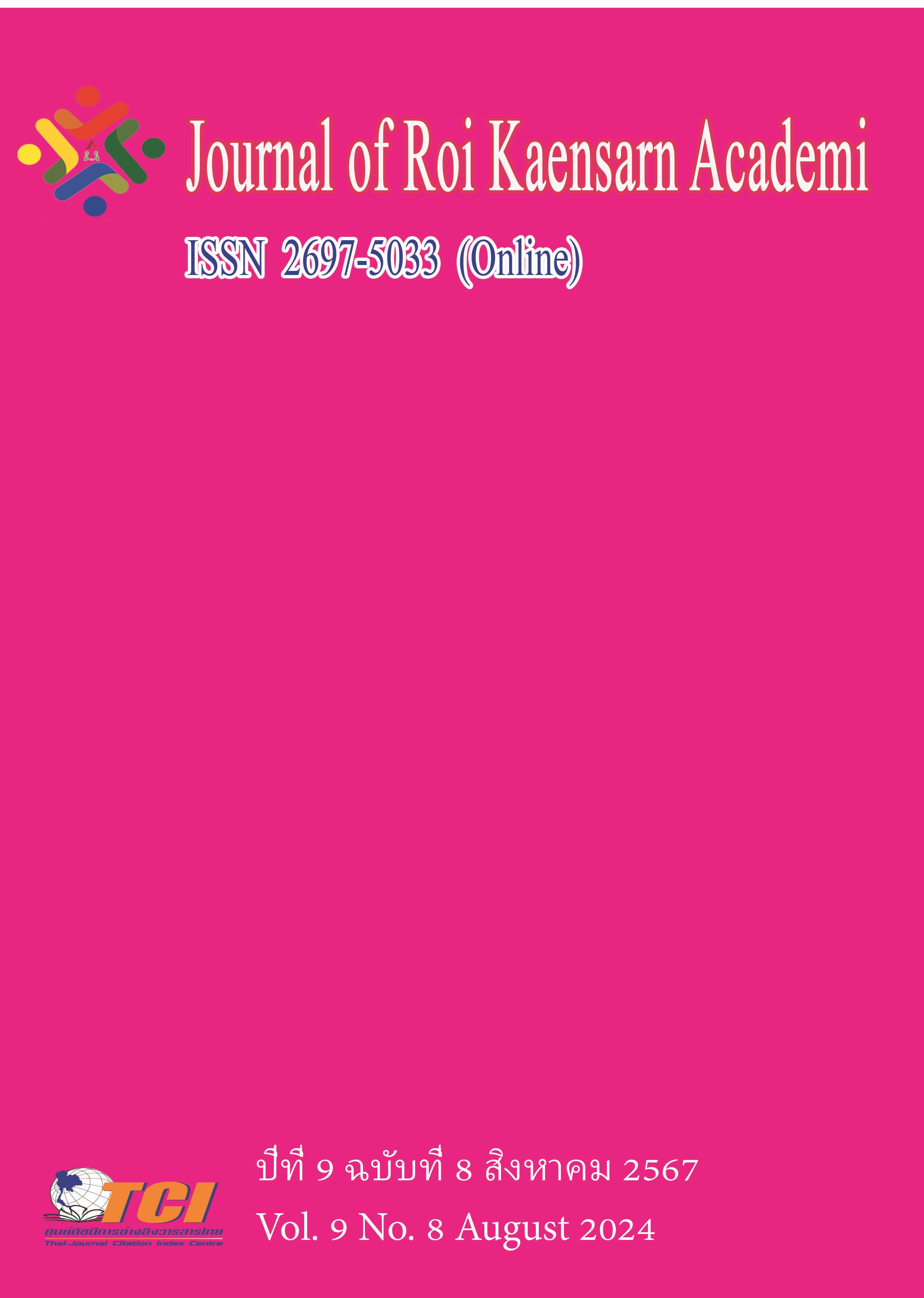การจัดการการท่องเที่ยวเชิงนิเวศวัฒนธรรมจากอัตลักษณ์วัฒนธรรมทะเลทรายซาพอโถว
Main Article Content
บทคัดย่อ
งานวิจัยเรื่อง การจัดการการท่องเที่ยวเชิงนิเวศวัฒนธรรมจากอัตลักษณ์วัฒนธรรมทะเลทรายซาพอโถว มีวัตถุประสงค์เพื่อ 1.) เพื่อสำรวจเส้นทางการพัฒนาของการอยู่ร่วมกันอย่างกลมกลืนของทรัพยากรธรรมชาติ ทรัพยากรวัฒนธรรม และชุมชนในพื้นที่พื้นที่ซาพอโถว 2.) เพื่อส่งเสริมการพัฒนาที่ยั่งยืนของการท่องเที่ยวเชิงนิเวศวัฒนธรรมในพื้นที่ซาพอโถว การวิจัยดำเนินการโดยใช้การวิจัยเชิงคุณภาพและเชิงปริมาณ ได้แก่ การสัมภาษณ์เชิงลึก การสังเกตผู้เข้าร่วม และแบบสอบถามประสบการณ์ ตัวอย่างการสัมภาษณ์ ได้แก่ หน่วยงานรัฐบาลพื้นที่ซาพอโถว นักวิชาการด้านวัฒนธรรม บุคลากรในชุมชน และผู้มีส่วนได้ส่วนเสียด้านการท่องเที่ยวเชิงวัฒนธรรม แบบสอบถามนี้ใช้เพื่อประเมินกิจกรรมการท่องเที่ยวเชิงนิเวศวัฒนธรรมของนักท่องเที่ยวในพื้นที่ซาพอโถว ผลการวิจัยพบว่าทรัพยากรนิเวศ ทรัพยากรทางประวัติศาสตร์ และวัฒนธรรม เกิดพื้นที่อยู่อาศัยในพื้นที่ซาพอโถว มีผลกระทบเชิงบวกต่อการพัฒนาการท่องเที่ยวเชิงนิเวศและวัฒนธรรม ทรัพยากรนิเวศน์และวัฒนธรรมของทะเลทรายและแม่น้ำฮวงโหอย่างเห็นได้ชัด จากการมีส่วนร่วมของชุมชนและสังคมในการพัฒนาภูมิภาคอย่างยั่งยืน นำไปสู่การการเสนอยุทธศาสตร์เพื่อส่งเสริมการจัดการการท่องเที่ยวเชิงนิเวศวัฒนธรรมในพื้นที่ชาโปโถว ได้แก่ 1) สร้างมาตรฐานและเป็นแนวทางพฤติกรรมการท่องเที่ยวของนักท่องเที่ยวเชิงวัฒนธรรมเชิงนิเวศ 2) เน้นหัวข้อหลักของการท่องเที่ยวเชิงวัฒนธรรมทะเลทรายและการท่องเที่ยวเชิงวัฒนธรรมแม่น้ำฮวงโหในพื้นที่ซาพอโถว 3) การบูรณาการทรัพยากรการท่องเที่ยวเชิงนิเวศและวัฒนธรรมในพื้นที่ทะเลทรายช่วยส่งเสริมการพัฒนาการท่องเที่ยวในระดับภูมิภาค สิ่งนี้สามารถส่งเสริมการพัฒนาที่ยั่งยืนของพื้นที่ซาพอโถว
Article Details
เอกสารอ้างอิง
Cheng, Z. (2019). Research on Optimization of Desert Tourism Resource Spatial Structure in China Based on Social Network Analysis. Inner Mongolia Science & Technology and Economy, (08), 10-12. doi:CNKI:SUN:NMKJ.0.2019-08-004.
Dang, X. H., Li, X. Y., Liu, J., Meng, Z. J., Bai, S. H., Zhai, B., & Liu, B. (2022). Current Situation and Development Prospect of Desert Tourism Resources Development and Utilization in China. Journal of Arid Land Resources and Environment, (07), 194-201. doi:10.13448/j.cnki.jalre.2022.191.
Dong, R. J., Dong, Z. B., & Cao, X. Y. (2014). Spatial Structure and Main Functional Zoning of Desert Tourism Resources in China. Journal of Desert Research, (02), 582-589.
Jiang, P. (2020). Path Selection for Green Development in Ecologically Fragile Areas—An Empirical Study of Tongyuan Village in Shapotou, Ningxia. Journal of Poyang Lake, (03), 52-60+125-126. doi:CNKI:SUN:PYHX.0.2020-03-008.
Li, D. H., Hao, M. X., & Zhu, H. (2018). Integration Research on Boundary Symbiotic Tourism Resources from the Perspective of Game Theory—A Case Study of Dabie Mountain Area. Journal of Jiangnan University (Humanities & Social Sciences Edition), (06), 106-112. doi:CNKI:SUN:WXQS.0.2018-06-016.
Li, J. F. (2015). Analysis of the Development and Utilization of Desert Tourism Resources in Ningxia—Taking Shapotou Scenic Area in Ningxia as an Example. Tourist Review (Fortnightly), (24), 174-175. doi:CNKI:SUN:LZHB.0.2015-12-117.
Li, Y., Li, F., & Wang, H. (2021). Research on the Perception and Evaluation of Ningxia Comprehensive Tourism Destination Image—Based on Content Analysis of 5A-level Scenic Area Network Comments. Times Economy, (02), 115-119. doi:10.19463/j.cnki.sdjm.2021.02.030.
Lin, M. S., Chen, Y. P., Li, W., Zeng, C. S., & Li, C. Y. (2022). Research on Ecological Adaptability Evaluation and Influencing Factors of Traditional Village Culture. China Ecotourism, (03), 504-518. doi:CNKI:SUN:STLY.0.2022-03-012.
Ren, Y. S., Lu, L., & Han, Y. G. (2022). Research Framework of Tourism Resources from the Perspective of New Tourism Resource View. Journal of Natural Resources, (03), 551-567. doi:CNKI:SUN:ZRZX.0.2022-03-001.
Sha Potou District People's Government Office. (December 2023). Government Work Report of Sha Potou District, Zhongwei City: Review of Work in 2023. Retrieved from https://www.spt.gov.cn
Ningxia Hui Autonomous Region Bureau of Statistics. (April 2023). Statistical Bulletin on National Economic and Social Development of Ningxia Hui Autonomous Region in 2022: Tourism and Social Services. Retrieved from https://www.nx.gov.cn/zwgk/zfxxgk/fdzdgknr/tjxx_40901/tjgb_40903/
Shi, L., Li, L. T., Zhang, G. L., Yang, P., & Gao, X. Y. (2016). Study on Tourism Environment Capacity of Desert Scenic Spots Based on LAC Theory—A Case Study of Sha Lake Tourist Area in Ningxia. Journal of Desert Research, (06), 1739-1747. doi:CNKI:SUN:ZGSS.0.2016-06-032.
Shi, L., Li, L. T., Zhang, G. L., Yang, P., Gao, X. Y., & Zhao, Y. P. (2018). Research on Functional Zoning of Desert Tourism Main Body Based on Suitability Analysis—A Case Study of Shapotou Area in Zhongwei City, Ningxia. Journal of Desert Research, (02), 437-443.
Sun, B. Y. (2021). Current Situation and Prospects of Desert-type Tourist Attractions Development in China. Journal of Desert Research, (01), 75-81.
Wang, P., Wang, Y. J., Liu, X. P., Chen, X., & Kong, F. X. (2018). Research on Ecosystem Service Value of Sha Potou Area Based on RS and GIS. Research of Soil and Water Conservation, (04), 250-256. doi:10.13869/j.cnki.rswc.2018.04.037.
Wang, X. J. (2019). Thinking on Integration of Traditional Culture of Northern Anhui and Huaihe Culture Tourism Resources Based on Regional Linkage Theory. Regional Governance, (43), 253-256. doi:CNKI:SUN:QYZL.0.2019-43-083.
Xiji Ri. (2013). Exploration of Desert Tourism and Its Exploration of Desert Tourism Development in China (Master's thesis, Inner Mongolia Normal University). Retrieved from https://kns.cnki.net/KCMS/detail/detail.aspx?dbname=CM

